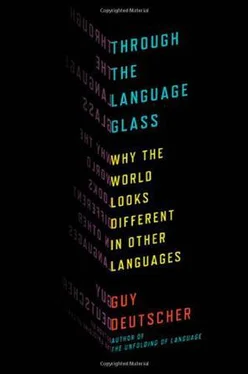Is the amount of information expressed within the word related to the complexity of a society? Are hunter-gatherer tribes, for example, more likely to speak in short and simple words? And are words likely to encapsulate more elaborate information in languages of advanced civilizations? In 1992, the linguist Revere Perkins set out to test exactly this question, by conducting a statistical survey of fifty languages. He assigned the societies in his sample to five broad categories of complexity, based on a combination of criteria that have been established by anthropologists, including population size, social stratification, type of subsistence economy, and specialization in crafts. On the simplest level, there are “bands” that consist of only a few families, don’t have permanent settlements, depend exclusively on hunting and gathering, and have no authority structure outside the family. The second category includes slightly larger groups, with incipient use of agriculture, semi-permanent settlement, and some minimal social organization. The third category is for “tribes” that produce most of their food by agriculture, have permanent settlements, a few craft specialists, and some form of authority figure. The fourth category refers to what is sometimes called “peasant societies,” with intensive agricultural production, small towns, craft specialization, and regional authorities. The fifth category of complexity refers to urban societies with large populations and complex social, political, and religious organizations.
In order to compare the complexity of words in the languages of the sample, Perkins chose a list of semantic features like the ones I mentioned above: the indication of plurality on nouns, tense on verbs, and other such bits of information that identify the participants, the time, and the place of events. He then checked how many of these features are expressed within the word, rather than through independent words, in each language. His analysis showed that there was a significant correlation between the level of complexity of a society and the number of distinctions that are expressed inside the word. But contrary to what Joe, Piers, and Tom might expect, it was not the case that sophisticated societies tend to have sophisticated word structures. Quite the opposite: there is an inverse correlation between the complexity of society and of word structure! The simpler the society, the more information it is likely to mark within the word; the more complex the society, the fewer semantic distinctions it is likely to express word-internally.
Perkins’s study did not really make waves at the time, perhaps because linguists were too busy preaching equality to pay much heed. But more recently, the increased availability of information, especially in electronic databases of grammatical phenomena from hundreds of languages, has made it easier to test a much larger set of languages, so in the last few years a few more surveys of a similar nature have been conducted. Unlike Perkins’s study, however, the recent surveys do not assign societies to a few broad categories of cultural complexity but instead opt to use just one measure, which is both more easily determined and more conducive to statistical analysis: the number of speakers of each language. Of course, the number of speakers is only a crude indication for the complexity of social structures, but the fit is nevertheless fairly tight: at the one extreme the languages of the simplest societies are spoken by fewer than a hundred people, and at the other the languages of complex urban societies are typically spoken by millions. The recent surveys strongly support Perkins’s conclusions and show that languages of large societies are more likely to have simpler word structure, whereas languages of smaller societies are more likely to have many semantic distinctions coded within the word.
How can such correlations be explained? One thing is fairly clear. The degree of morphological complexity in a language is not usually a matter of conscious choice or deliberate planning by the speakers. After all, the question of how many endings there should be on verbs or nouns hardly features in party political debates. So if words tend to be more elaborate in simple societies, the reasons must be sought in the natural and unplanned paths of change that languages tread over time. In The Unfolding of Language , I showed that words are constantly buffeted by opposing forces of destruction and creation. The forces of destruction draw their energy from a rather unenergetic human trait: laziness. The tendency to save effort leads speakers to take shortcuts in pronunciation, and with time the accumulated effects of such shortcuts can weaken and even flatten whole arrays of endings and thus make the structure of words much simpler. Ironically, the very same laziness is also behind the creation of new complex word structures. Through the grind of repetition, two words that often appear together can be worn down and, in the process, fuse into a single word-just think of “I’m,” “he’s,” “o’clock,” “don’t,” “gonna.” In this way, more complex words can arise.
In the long run, the level of morphological complexity will be determined by the balance of power between the forces of destruction and creation. If the forces of creation hold sway, and at least as many endings and prefixes are created as are lost, then the language will maintain or increase the complexity of its word structure. But if more endings are eroded than created, words will become simpler over time.
The history of the Indo-European languages over the last millennia is a striking example of the latter case. The nineteenth-century German linguist August Schleicher memorably compared the sesquipedalian Gothic verb habaidedeima (first-person plural past subjunctive of “have”) with its cousin in modern English, the monosyllabic “had,” and likened the modern form to a statue that has been rolling around on a riverbed and whose limbs have been worn away, so that hardly anything remains but a polished stone cylinder. A similar pattern of simplification is evident also with nouns. Some six thousand years ago, the ancient ancestor, Proto-Indo-European, had a highly complex array of case endings that expressed the precise role of the noun in the sentence. There were eight different cases, and most of them had distinct forms for singular, plural, and dual, creating a mesh of almost twenty endings for each noun. But in the last millennia this elaborate mesh of endings largely eroded in the daughter languages, and the information that had previously been conveyed through endings is now mostly expressed with independent words (such as the prepositions “of,” “to,” “by,” “with”). For some reason, then, the balance tipped toward destruction of complex morphology: old endings eroded, while relatively new fusions materialized.
Can the balance between creation and destruction have anything to do with the structure of a society? Is there something about the way people in small societies communicate that favors new fusions? And when societies become larger and more complex, can there be something in the communication patterns that tilts the balance toward simplification of word structures? All the plausible answers suggested so far go back to one basic factor: the difference between communication among intimates and among strangers.
To appreciate just how often we who live in larger societies communicate with strangers, just try to do a quick count of how many unfamiliar people you talked to over the last week. If you live a normally active life in a big city, there would be far too many to remember: from shop assistants to taxi drivers, from phone salespeople to waiters, from librarians to policemen, from the repairman who came to fix the boiler to the random person who asked you how to get to such-and-such street. Now add up a second circle of people who may not be complete strangers but whom you still hardly know: those you only occasionally meet at work, at school, or at the gym. Finally, if you add to these the number of people you have heard without actively speaking to, on the street or on the train or on television, it will be obvious that you have been exposed to the speech of a vast crowd of strangers-all in just one week.
Читать дальше











